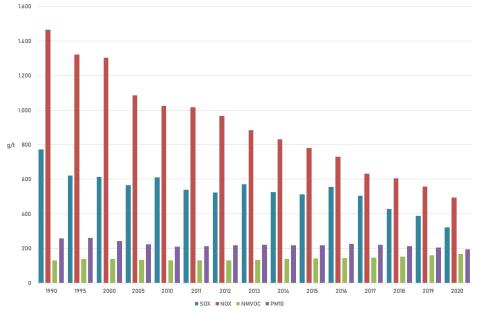Panel 1
Riccardo De Lauretis
The indicator relates the total atmospheric emissions generated by the production processes of the non-metallic mineral industry sector to the total quantities produced, in order to assess the specific emissions associated with the production of one unit of product. In 2020, compared to 2019, the specific emissions of all substances considered decreased, except for NMVOCs, which showed a slight increase.
The indicator relates total emissions of air pollutants generated by the production processes of the non-metallic mineral industry (cement, lime, glass, bitumen/asphalt) to total quantities produced. The atmospheric pollutants observed are: SOx (sulphur oxides); NOx (nitrogen oxides); NMVOCs (Non-Methane Volatile Organic Compounds); PM10 (particulate matter) and CO₂ (carbon dioxide).
The emissions used in the indicator calculation are estimated through appropriate methodologies in line with EMEP/EEA guidelines. The annual update of emissions involves revising the entire time series based on improved information and the most recent methodological developments. This review process may lead to significant variations in the historical data presented. Given the level of aggregation chosen, the indicator provides information on the specific emissions of the entire sector rather than of individual production processes.
The purpose is to evaluate the specific emissions generated by the production of a unit of product in the non-metallic mineral industry.
Specific environmental emissions in the industrial sector are regulated by Directive 2010/75/EU of 24 November 2010, transposed into Italian law by Legislative Decree no. 46 of 4 March 2014, which amended Legislative Decree 152/06 and subsequent amendments. This legislation defines, for each industrial sector, the obligations to be met in terms of pollution prevention and reduction, also through the adoption of Best Available Techniques (BATs).
It also requires the exchange of information within the European Community, including emissions data for activities subject to Integrated Environmental Authorization (IEA).
Panel 2
Rapporto ISPRA 361/2022 - Italian Emission Inventory, 1990-2020. Informative Inventory report 2022.
Data quality assessment
Industry Associations, ISPRA (Italian Institute for Environmental Protection and Research), ISTAT (National Institute of Statistics)
The activity data and emissions are documented in the National Air Emissions Inventory, specifically in the "ISPRA Report 361/2022, Italian Emission Inventory, 1990–2020. Informative Inventory Report 2022", and in the emission data tables by category officially submitted by Italy under the UNECE/CLRTAP Convention.
National
1990-2020
Indicator assessment
Ratio between atmospheric emissions estimated by ISPRA in the context of the National Air Emissions Inventory and the production of non-metallic mineral industry that generates air emissions.
In 2020, compared to 2019, the specific emissions of all substances considered—except for NMVOCs—decreased. In particular SOx emissions (322.47 g/t) decreased by 16.7%, NOx emissions (493.92 g/t) by 11.2%, PM10 emissions (193.95 g/t) by 5.5%, CO₂ emissions (346.25 kg/t) by 8.3%. NMVOC emissions (166.65 g/t) increased by 4.5%.
From 1990 to 2020, there is a general reduction in pollutants, with the exception of NMVOCs (+27.9%), which show an increasing trend throughout the historical series. Specifically, the decrease was 58.2% for SOx, 66.3% for NOx, 25.1% for PM10, 31.7% for CO₂. While the trends for SOx, NOx, and PM10 can be defined as positive, the trend for NMVOCs is negative, so the trend associated with the indicator, as a whole, is “not definable.”
Data
Table 1: Specific emissions in the non-metallic minerals industry.
ISPRA elaboration on data from ISPRA, ISTAT and Trade Associations.



Analysis of the historical series highlights a significant reduction in specific emissions values since 1990 for all substances considered, except for NMVOCs, which are increasing (see Table 1 and Figures 1 and 2).
For SOx and NOx, the trend in specific emissions has been steadily decreasing. For PM10, the reduction occurred primarily between 1990 and 2010 while from 2011 to 2018, it remained relatively stable, with a further decrease starting in 2019.
In the case of NMVOCs, the specific emission remained generally stable between 1990 and 2012, while in the following years it shows a marked increase.
The annual trend of emissions for each pollutant is determined by the production trends of the respective emitting processes.